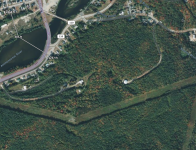Avon Avians
Well-known member

Hello folks!
I'm sure that many of you wildlife enthusiasts out there have wildlife ponds.
I believe that a wildlife pond is basically a fishless pond that mostly balances itself out without much of any need for maintenance, at least once established.
Am I correct?
Anyway, we have an abundance of green frogs and bullfrogs in a nearby pond only about a mile or so away, and we get a lot of frogs hopping about in our town during heavy rains and wet seasons (we live in New Hampshire, New England). I doubt that it would be difficult to make our yard a hospitable home for them.
I had considered building a pond to attract these frogs. For whatever reason, attracting newts to the pond was not something that I considered to be possible.
Over time, I realized that attracting newts was probably not that much of an impossibility, since they have efts that travel overland on rainy nights.
Around here, we have only one species, the eastern or red-spotted newt. It's the only newt out of our many salamander species, and is our state amphibian.
From what I've heard, they prefer sunny, weedy ponds with shallow water. The efts seem to prefer damp woodlands with rotten wood and other moist or wet areas.
Is this what anyone else has experienced? I know that many of the other wildlife enthusiasts on this forum live outside of North America where eastern newts are absent but many species are present. I believe that these newt have similar habits to our species.
If any one has newts in their backyard pond or has had them in the past, then I would love to hear your suggestions or ideas about what attracts them.
Even observations of newt behavior in captivity may help.
Any input would be appreciated. Thanks! God bless!
I'm sure that many of you wildlife enthusiasts out there have wildlife ponds.
I believe that a wildlife pond is basically a fishless pond that mostly balances itself out without much of any need for maintenance, at least once established.
Am I correct?
Anyway, we have an abundance of green frogs and bullfrogs in a nearby pond only about a mile or so away, and we get a lot of frogs hopping about in our town during heavy rains and wet seasons (we live in New Hampshire, New England). I doubt that it would be difficult to make our yard a hospitable home for them.
I had considered building a pond to attract these frogs. For whatever reason, attracting newts to the pond was not something that I considered to be possible.
Over time, I realized that attracting newts was probably not that much of an impossibility, since they have efts that travel overland on rainy nights.
Around here, we have only one species, the eastern or red-spotted newt. It's the only newt out of our many salamander species, and is our state amphibian.
From what I've heard, they prefer sunny, weedy ponds with shallow water. The efts seem to prefer damp woodlands with rotten wood and other moist or wet areas.
Is this what anyone else has experienced? I know that many of the other wildlife enthusiasts on this forum live outside of North America where eastern newts are absent but many species are present. I believe that these newt have similar habits to our species.
If any one has newts in their backyard pond or has had them in the past, then I would love to hear your suggestions or ideas about what attracts them.
Even observations of newt behavior in captivity may help.
Any input would be appreciated. Thanks! God bless!




